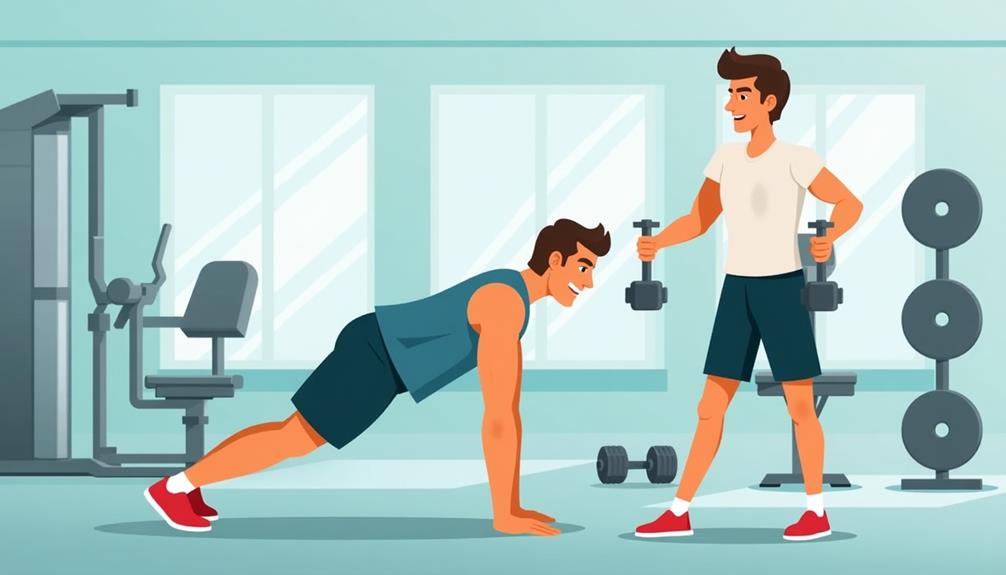To master the upper body resistance circuit, follow these three steps.
Understand the Basics: Familiarize yourself with major muscle groups like the chest, back, shoulders, and arms.
Choose the Right Exercises: Focus on compound movements such as push-ups, pull-ups, and bench presses, which engage multiple muscles and promote balanced strength.
Plan Your Workout Routine: Set your goals and schedule at least two to three upper body sessions weekly. Each session should include a warm-up, main exercises, and a cool-down.
By integrating these strategies, you'll enhance your upper body training, and there's more valuable information ahead.
Core Insights
- Identify your goals: Determine whether you aim for strength, endurance, or muscle tone to tailor your circuit effectively.
- Choose compound exercises: Incorporate movements like push-ups, bench presses, and pull-ups to engage multiple muscle groups simultaneously.
- Structure your routine: Plan workouts with a warm-up, main exercises, and a cool-down, ensuring a balanced approach to training.
- Schedule consistently: Aim for two to three upper body sessions per week, allowing recovery days for optimal results.
- Track and adjust: Monitor your progress and modify weights, sets, or reps to maintain engagement and challenge your muscles.
Understand the Basics

Understanding the basics of upper body resistance training is necessary for anyone looking to build strength and improve overall fitness. It involves working your major muscle groups, including the chest, back, shoulders, and arms. By engaging these muscles, you can enhance your functional strength, making everyday tasks easier. When starting your resistance training journey, it's important to choose the right equipment. Resistance bands are an excellent option for home workouts, offering versatility and various resistance levels to suit your needs.
You'll want to familiarize yourself with key concepts like sets, reps, and rest periods. A set is a group of repetitions, while a rep is one complete motion of an exercise. Rest periods are essential for recovery and muscle growth, so don't skip them. Additionally, proper form is critical to prevent injuries and maximize effectiveness. By grasping these foundational elements, you'll be better prepared to approach your upper body resistance circuit with confidence and purpose.
Choose the Right Exercises

Now that you've grasped the basics of upper body resistance training, it's time to select the right exercises for your circuit. Choosing the right movements will target your major muscle groups effectively. Focus on compound exercises that engage multiple muscles at once, such as push-ups, pull-ups, and bench presses.
Here's a quick reference table to help you decide:
| Exercise | Target Muscles |
|---|---|
| Push-Ups | Chest, Triceps, Shoulders |
| Pull-Ups | Back, Biceps |
| Dumbbell Press | Chest, Shoulders |
Incorporate these exercises into your routine for balanced strength development. Remember, variety keeps your workouts engaging while ensuring all key areas are addressed.
Plan Your Workout Routine

Creating a well-structured workout routine is essential for maximizing your upper body resistance training results. Start by determining your goals. Are you aiming for strength, endurance, or muscle tone? Once you know your objectives, you can select appropriate exercises. For an added challenge, consider incorporating weighted vests into your routine, which can intensify your workouts and accelerate progress.
Next, consider your schedule. Aim for at least two to three upper body sessions per week, allowing for recovery days in between. Structure each workout to include a warm-up, main exercises, and a cool-down.
For the main exercises, focus on compound movements like bench presses, rows, and pull-ups, which target multiple muscle groups. Finally, track your progress. Adjust your weights, sets, or reps as you get stronger. This approach keeps your routine effective and engaging.
Frequently Asked Questions
How Often Should I Perform the Upper Body Resistance Circuit?
You should perform the upper body resistance circuit about two to three times a week. This frequency allows your muscles to recover while promoting strength gains. Listen to your body and adjust as needed.
Can I Combine This Circuit With Cardio Workouts?
Absolutely, you can combine the upper body resistance circuit with cardio workouts! Just alternate between strength and cardio exercises. It'll keep your routine balanced, boost your endurance, and help you achieve better overall fitness results.
What Equipment Do I Need for This Circuit?
You'll need some basic equipment for this circuit. Grab dumbbells or resistance bands, a sturdy bench, and a mat. These tools help you target your upper body effectively and get the best results from your workout.
Is It Suitable for Beginners or Only Advanced Athletes?
Yes, it's suitable for beginners and advanced athletes alike. You can modify the exercises to match your fitness level, ensuring you're challenged without risking injury. Everyone can benefit from this upper body workout!
How Can I Avoid Injuries While Performing These Exercises?
Think of your body as a delicate instrument; to play it well, warm up, use proper form, listen to your limits, and rest. These steps guarantee you avoid injuries and keep your performance strong and safe.

